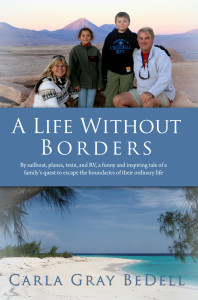The bus ride from Lima to Nazca seemed surprisingly quick, though it was about 7 hours. On board the bus we watched movies, read books, slept a little and watched the countryside. There was even an onboard Bingo Game and Tessa won a bottle of Pisco (the famous alcohol of Peru). This is where our luggage started to expand. Once we arrived in Nazca we found a tourist agency, ironically called Alegria Tours, and purchased tickets for the flight over the Nazca lines. The tour company agreed to hold our bags, then took us to the airport, where we watched a short video on the history of the Nazca lines. At first we were reluctant to leave our bags, but we couldn’t take our heavy backpacks and suitcase with us, so contrary to what the Lonely Planet guide says, we trusted them and left our stuff.
Some history on the Nazca Lines.
In 1901, a Peruvian archaeologist discovered the remnants of the Nazca culture. This culture existing from between 900 BC and 600 AD was unique from the other coastal peoples primarily by their distinctive advanced pottery, and the Nazca lines. The Nazca lines, discovered in 1939, are a series of drawings and lines, picturing such things as spiders, monkeys, condors, that can only be seen from the air. They really can’t be seen at ground level, and it’s only when you get in the air that you can see how they all interconnect. The big question, if you can only see them from the air, why did they make them when they couldn’t see them and how could they see what they were doing? I had heard about the lines before and was really excited about seeing them, but I only thought there were 3 or 4 figures, but there are actually hundreds of drawings, made by removing the reddish desert stones, piling them up on either sides of the line, and exposing the lighter dirt/sand to show through.
We piled into the small 6 seater plane, Tristan in front with the pilot, Dan and Tessa in the middle and I in the back. I hadn’t stopped to think before that I could get airsick like I did last time I went up in a glider. I just hoped the ride wasn’t going to be too rough. It was a little. First, it was hot. Extremely hot in the plane. My face was dripping sweat hot. Second, there was a little turbulence in the late afternoon, the morning flight is supposed to be much smoother. Third, the pilot would be flying level, then we would cross over the object, for example the whale. He would then yell “Whale” in broken english and bank the plane sharply. So the ride kind of went like this.
Fly level. Turbulence. Sweat “Monkey!” Bank 90 degrees. Fly level . Turbulence . Sweat. “Monkey Upside down!” Bank 90 degrees. Sweat. And so on. You get the idea. Thank goodness we took the guidebook advice and hadn’t eaten before we went!
Dan turns to me and says “Tristan is getting sick.” His head was rolling back and then plasters itself against the window. A few minutes later Dan says “Tristan’s asleep.” Same with Tessa. So here is one of Tristan’s dreams, to go up in a small airplane and he falls asleep. Well, Dan and I stayed awake to see the Whale, Monkey, Tree of Life, Astronaut (also called the Owl), Condor, Hummingbird,Spider and a few others. We enjoyed it, but mercifully it ended after about 30 to 40 minutes.
Bottom line, I’m glad we did it. If we would have passed it up I would have felt like I missed something. But truly, this is one instance when you could probably got as much out of it by looking at the brochure.
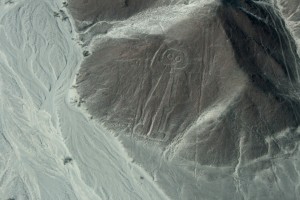 Astronaut or Owl
Astronaut or Owl
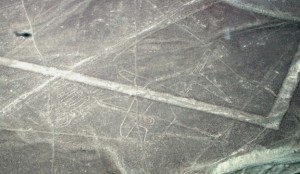 Whale (Upside down)
Whale (Upside down)
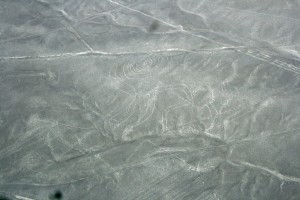 Monkey
Monkey
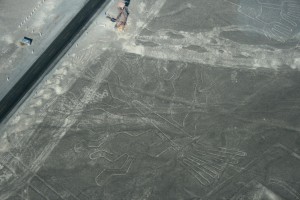 Tree of Life
Tree of Life
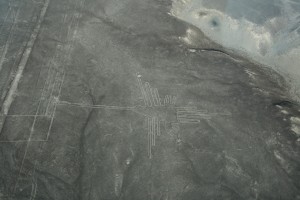 Hummingbird
Hummingbird
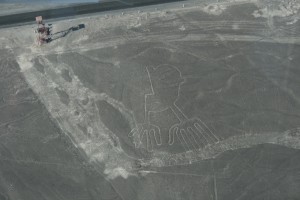 Hands
Hands
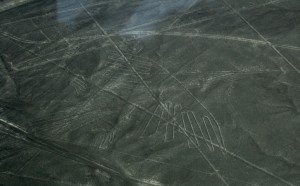 Condor
Condor
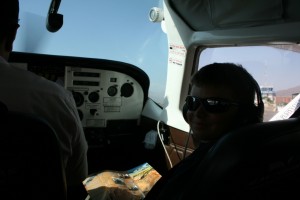 Tristan on the plane
Tristan on the plane
After the flight, we went to get our bags and they said they would hold them for us until our bus left that evening. Very nice. So we walked into town, ate a late lunch, and decided how we were going to spend our time waiting for the bus. It was 5 pm and our bus didn’t leave until ten pm. We walked downtown to the Plaza de Armas, sat on the bench and people watched for awhile. Everyone smiled at us. It was a friendly town. They seemed very curious about the kids. I guess they haven’t seen many American families. As it turned dark, we headed to a cofffe shop to get an expresso and ice cream for the kids. On the way, the kids played in a bouncy house set up off the square. That was a nice treat for them. Later, at the coffee shop, a Taiwanese couple started talking to us. They had just moved to Pennsylvania, and were on a 2 week tour of Peru. They were going to hike the Inca Trail. We spent the next few hours tallking to them, while Tessa sat outside talking to the coffee shop owner and playing with his dog and new kitten. Later we retrieved our bags from Alegria Tours (everything was there) and boarded our bus to Arequipa.
I thought we might go right to sleep but the bus was playing a movie, so we all stayed awake for that. At six am the next morning we pulled into the bus station at Arequipa. We didn’t really have an idea of a Hotel, we had a few ideas from the Lonely Planet. There was a tourist desk there and we asked him about the hotels we were thinking of and he suggested the Posada de San Juan, near the Plaza de Armas. It was a little more than than the one we were thinking of, but it included free transportation to the hotel, and had free computer/internet.
The hotel was nice and let us have a very earlycheck in. Our room was on the top floor which ended up being a suite with a double bed and TV in one part and 3 single beds and TV in the other section. Outside our room was a patio, and a great view of the volcano El Misti.
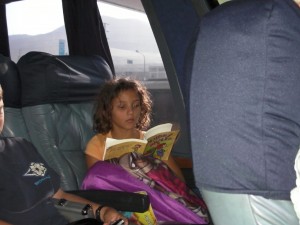 Tessa reading on the bus
Tessa reading on the bus
Our first priority was eating, so once we had showered, and changed clothes, we started walking around town. After eating at a corner chicken place we found a pharmacy and bought some altitude sickness pills and some dramamine. I was worried about getting motion sickness from how fast the bus drivers drove on the winding mountain roads, and Dan was worried about getting altitude sickness as we were headed to Colca Canyon the next day, and the passage went over 16000 feet.
One tour we took was the Museo Santury. This museum holds the remains of the frozen bodies of Inca children left as sacrifices on the summit of Nevado Ampato over 500 years ago. The most famous body is Juanita, as she is perfectly frozen, not a mummy, but frozen with most of her skin and all of her nails and hair. Unfortunately she was off display until May 1st, but we did get to see another little girl that was discovered in the mountains around Arequipa. They are held in a special sealed glass freezer, which still holds pieces of ice. It’s fascinating. The Incas made several sacfrifices of female children to the mountain Gods. The most beautiful girl would be chosen and the trip would take over 2 months, climbing to the top of the tall peaks. They used no special equipment, only sandals on their feet, chewing Coca leaves on the way for altitude sickness. What I can’t imagine is what must have gone through the minds of these young girls. And what about her parents? How did they feel? Yes, it was deemed an honor, but to knowingly send your child to death? The reason for the sacrifices? The Incas had a premonition of something bad coming. They thought it was from the Mountain Gods, but it really was the premonition of the Spanish coming, and wiping out their civilization. An entire civilization.
In addition to the sacrifices, we learned how advanced the Incas were, especially in the field of medicine. Mothers used to save the umbilical cord from their babies birth and feed some to the child if they bacame badly sick. Sounds like stem cell doesn’t it? I always find it amazing the long and winding road it takes our medical science to get back to some of the natural cures that have been around for centuries! We all left the museum deeply affected.
Later that afernoon I started feeling sick and we went back to the hotel. I was in for the night. The kids watched TV while Dan sat outside talking to 2 Canadian couples and an Australian woman named Diane, who had been living at the hotel for awhile. The kids started getting hungry later, but I couldn’t keep anything IN, so Diane took Dan and the kids on a tour through downtown. They brought back pizza and cheesecake which they enjoyed but I couldn’t eat. I was worried that I would be sick for the tour the next day to Colca Canyon.
Sure enough, I was.

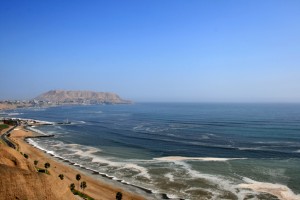 Mira Flores
Mira Flores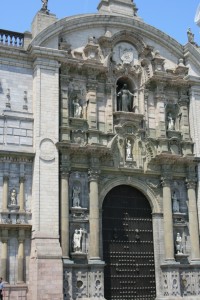 Iglesia de la Merced
Iglesia de la Merced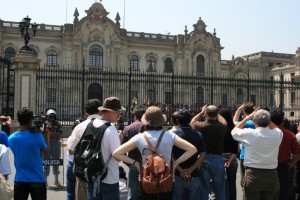 Presidential Palace
Presidential Palace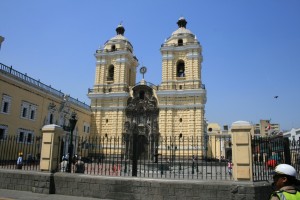 Monasterio de San Francisco
Monasterio de San Francisco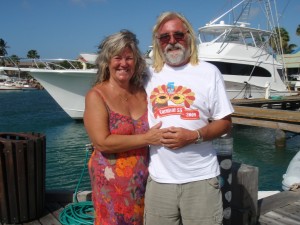 Mike and Ineke
Mike and Ineke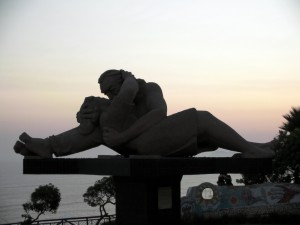 Lover’s Park Mira Flores
Lover’s Park Mira Flores